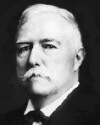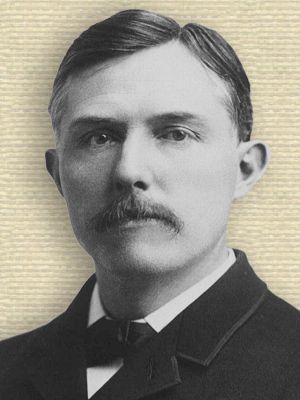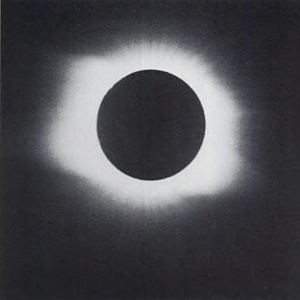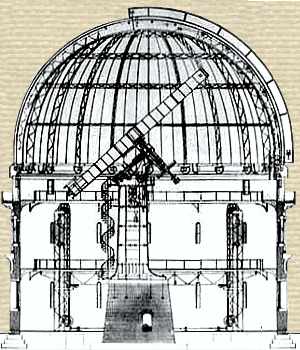 (source)
(source)
|
Edward Emerson Barnard
(16 Dec 1857 - 6 Feb 1923)
American astronomer , who pioneered in wide-field celestial photography. He made the first photographic discovery of a comet and identified the fifth moon of Jupiter.
|
EDWARD EMERSON BARNARD.
by J. A. Parkhukst.
from Journal Royal Astronomical Society of Canada
[p.49] Our profound sorrow at Barnard’s death is relieved by thoughts of the rich legacy of memories which he left us. He was an example of the possibilities which America offers to its youth. Nowhere else in the world could a boy rise from such restricted and difficult conditions to such a complete and abundant manhood, honored equally for friendly character and high scientific attainments. In attempting to sketch his life, one is embarrassed by the multitude of things which should be told to give anything like a complete idea of the man and his work.
Barnard’s life falls naturally into three periods: His youth, education, and the beginnings of his scientific career in Nashville, Tenn.; his rich contributions to astronomy from the Lick Observatory from 1888 to 1895; his life and work at Yerkes from 1896 to his death.
The story of his early life is most romantic, though some features of his early youth during the war were so sad that he could not be persuaded to repeat them. Born after the death of his father, the family endured such poverty that they gladly rescued Army hardtack found floating down the river. Yet in these hard circumstances he learned to be reliable, and his mother found work for him in the photograph gallery of Van Stavoren, because they could depend on him to keep the solar camera, used in making direct enlargements, on the roof pointed toward the sun, while other boys would fall asleep at the task. At the early age of 9 he took this job, and soon began his astronomical observations by marking on the roof the position of the shadow of the chimney when the clock in the neighboring tower struck 12. But the shadow did not return to the same place at later noons, and so the equation of time was independently discovered. No wonder that he was later called by Sir Robert Ball the foremost observational astronomer in the world.
Barnard’s kindly nature once led him to lend $2 of his hard-earned money to a boy friend, who could not repay the money but gave him instead a copy of Dick’s Christian Philosopher, which uses astronomy as one of the sciences illustrating the relation of nature to religion. This delicious old book turned the attention of the boy to the heavens, and thus his life work was determined beyond recall. A lens found on the street was put in a paper tube and made his first spyglass; then a better lens and a brass tube began to reveal the universe to the eager youth. What ecstasy that meant can be appreciated only by those who have traveled the same road.
[p.50] Meanwhile the boy was becoming proficient in photography, a fact of greatest importance in directing his future work. He was also making friends, some of whom could aid in his untiring efforts to acquire knowledge. J. W. Braid in his spare time was grinding lenses in the gallery, and, best of all, P. R. Calvert came from England and became associated with them in 1875. In 1877 the American Association met in Nashville and Barnard sought advice from the famous astronomer, Simon Newcomb, who told him that he could never advance in astronomy without much more mathematics than he knew. Cold comfort to a boy who had had only two months’ schooling in his life. But he accepted the challenge.
Barnard’s first ride on a railroad took him to Pittsburgh in search of John A. Brashear’s home. Barnard was too timid to knock at the door, and paced back and forth till he was weary before he dared to make himself and his errand known. Needless to say he had a hearty reception, and the friendship there begun between such congenial souls was enduring, and so intimate that they were Johnnie and Eddie to each other.
Barnard acquired a 5-inch telescope in 1877 and began observing the planet Jupiter, which was destined in after years to add so much to his fame. In January, 1881, he was married to Miss Rhoda Calvert, sister of the Calvert brothers who later managed the photograph gallery. He began that year to make systematic search for comets. His first discovery was made on the morning of May 12, 1881, finding “a very faint comet in the field with the star α Pegasi. No motion was detected between 3 and 4 a. m. The following morning it had disappeared from the place, but was found again as daylight was whitening the sky, very closely north following α Pegasi, and only visible when the bright star was hidden by the ring micrometer. No doubt now remaining that it was a comet, Barnard telegraphed to Swift (at Rochester, N. Y.), but neither he nor the discoverer could find it on the morning of the 14th or afterwards. Careful search was made at Boston, Cambridge, Clinton, and in other places, but without success.” In after years Barnard’s reputation would have placed this comet on the list without question, but coming from a young and unknown observer, it was not fully accepted, and it does not appear as his first comet. However, on September 17 of the same year he found that comet known as 1881 VI, and September 13 of the next year comet 1882 III.
Bishop McTyeire and Chancellor Garland, of Vanderbilt University recognized in Barnard a coming genius and became his life-long friends. In 1883 the latter invited him to take charge of the university observatory, with its 6-inch telescope, and at the same time to take special courses in mathematics, the sciences, and language. During his connection with the university, from 1883 to 1887, he [p.51] discovered seven comets, and paid for his house from the reward of $200 offered for each discovery by Warner, of Rochester. For years there was a lively race between Barnard and Brooks, of Phelps, N. Y:, in these discoveries. Of the 19 new northern comets found in 1885 to 1888, Brooks has the credit for 8 and Barnard 7, leaving only 4 for the rest of the world. An interesting by-product of the comet work was his independent discovery of the Gegenschein, October 4, 1883. He was graduated from the Vanderbilt University in 1887 and the same year was called to the newly organized Lick Observatory along with Burnham, Keeler, Schaeberle, and Hill.
The second period of his life, at the Lick Observatory from 1888 to 1895, was crowded full of productive work, with equipment greatly superior to that at Nashville; in fact, the best in the world at that time. As outstanding features may be mentioned his photographs of the solar corona at the eclipse of January 1, 1889, the discovery of the fifth satellite of Jupiter September 9, 1892, his micrometric measures of the diameters of the asteroids, Ceres, Pallas, Juno, and Vesta, and the old satellites of Jupiter; but these give but slight idea of his industrious, painstaking, and brilliant work during that period. Not long after the solar eclipse of 1889 the 6-inch Willard lens was secured, and Barnard began those epoch-making photographs of comets and the Milky Way which endure as perhaps his greatest contribution to astronomy. On account of difficulties in reproduction, the first collection only appeared in 1913 as Volume XI of the publications of the Lick Observatory, financed by individual subscriptions secured by Barnard himself. The beautiful collotype reproductions of plates of 39 comet and 88 Milky Way fields remain unexcelled in their delineation of these interesting objects.
This is not the place for a catalogue of the important papers on the moon, Mars, Jupiter and its satellites, Saturn with its rings and Titan, the nebulae, comets, and Milky Way, published by Barnard during his connection with the Lick Observatory. Suffice it to say that they demonstrate his unrivaled powers of observation and clearness of description, and also his skill in photography, diligently pursued since his boyhood in the gallery at Nashville. He loved California, its mountains, trees, flowers, and animals, with an ardor equal to that of a native son. Once on returning to his house at dawn after a night at the observatory, he relates that he was met near the door by a mountain lion. Each eyed the other for some moments with respect, then the lion quietly retired from the scene. Again he met a little dog, evidently a stray. Petting it for a moment he passed on. Soon the dog ran to him yelping wildly. Barnard saw that it had been struck by a snake. He first killed the rattler and then gave the dog some remedy, but too late to save his life. He afterwards regretted that he had not administered the remedy first [p.52] and killed the snake later. He and Burnham were in the habit of taking long tramps in the mountains, and many are the exciting tales told of these rambles.
Barnard was appointed astronomer at the Yerkes Observatory of the University of Chicago in the summer of 1895. With Director Hale the staff included Burnham, Wadsworth, Ellerman, and Ritchey. His work with the great 40-inch refractor began in the spring of 1897, and ended only with his fatal illness in December, 1922. His ripe experience enabled him to select lines of research which could be continued to advantage over long terms of years. The importance of such long series, coupled with his great ability as an observer; can hardly be overestimated. Among these, the work on planets and their satellites naturally took a prominent place. The fifth satellite of Jupiter, the fainter satellites of Saturn, and all those of Uranus and Neptune, were regularly measured, thus furnishing homogeneous series of greatest value. Of equal length and importance were his observations of Novae. He developed a method of measurements of the color of these new stars by taking advantage of the color curve of the objective and noting the focal settings. He made efforts, without success, to identify Tycho’s Nova of 1572. He remeasured the positions and regularly estimated the magnitude of all the old Novae which were visible with the 40-inch.
His most extensive research with the 40-inch was on the clusters.1 These were photographed with a yellow color filter on isochromatic plates, and also triangulated with great care with the visual micrometer. The final reduction of these measures, which is planned, will furnish not only a most valuable record but also a comparison between large-scale photographs and visual measures.
The continuation of his photographic work on comets and the Milky Way was made possible by a gift from Miss Bruce, of New York, in 1897, of sufficient funds to purchase, mount, and house a camera of the best obtainable quality. Barnard made his third trip to Europe (December, 1899, to March, 1900) in search of the best possible lens. Many samples were submitted and tested, but the lens finally chosen was made by Brashear. The mounting, by Warner and Swasey, held besides this 10-inch lens, a 6-inch doublet which had been refigured by Brashear, and a 5-inch guiding telescope. This was completed in 1904, used by Barnard in 1905 at Mount Wilson Observatory on the southern regions of the Milky Way, and since then in the ‘“Bruce” dome at Yerkes in photographing comets and completing his great “Atlas of the Milky Way,” which will be published by the Carnegie Institution in the present year. This atlas will contain plates of 50 of the most interesting regions of the [p.53] Milky Way, the majority being south of the Equator. Excluding areas duplicated, they will cover upward of 2,000 square degrees. The copies are silver prints made on Azo paper by Copelin of Chicago. The scale will average 2′ to the millimeter.
Barnard took part in three successful expeditions for photographing the solar corona at total eclipses. In the first, January 1, 1889*, at Bartletts, Calif., he secured excellent plates with nonphotographic telescopes of 9, 23, and 49 inches focal length. At his second eclipse, May 28, 1900, at Wadesboro, N. C, as member of the Yerkes party, he used a coelostat of 62 feet focal length, and in collaboration with Ritchey secured very fine results. He was member of the Naval Observatory party at the Sumatra eclipse of 1901, but was unfortunately prevented by clouds from making any exposures. At the eclipse of June 8, 1918, he was a member of the Yerkes party. He took photographs with the Brashear refractor of 12 inches aperture and 18 feet focal length, and was assisted at the 62-foot coelostat by Miss Mary R. Calvert. Although hindered by clouds, both sets of plates were excellent. He was somewhat exhausted by the laborious preparations for the eclipse and discouraged by the cloudiness, but was nevertheless alert during the following evening and was first of the party to notice Nova Aquilae 3, the discovery of which restored him to his usual freshness of spirit.
Barnard was given honorary degrees by Vanderbilt and Queen’s Universities and the University of the Pacific. He was awarded the Lalande, the Arago, and the Janssen gold medals of the French Academy of Sciences, the gold medal of the Royal Astronomical Society, the Bruce gold medal of the Astronomical Society of the Pacific, and the Janssen prize of the French Astronomical Society. He was a member of the American Academy of Sciences, the National Academy of Sciences, the American Philosophical Society, and many other scientific associations.
Barnard took great delight in entertaining guests and in imparting astronomical information. His enthusiasm, his wonderful memory and his beautiful photographs made his lectures rich treats. There were so many similarities in heart and intellect between Barnard and Brashear that the tribute paid the latter by George M. P. Baird is appropriate for Barnard:
Pilgrim of starry trails, far-traced to the last sun’s bound,
Voyager of sapphire seas, sounder of depth profound,
Meeting the pregnant void, reckoning the bonds that bind
Planet and asteroid, with golden measures of mind;
Heart of a little child, thought of a mage renowned,
Simple of life and aim, humble in vict’ry, crowned
By loves that his heart made warm, and truths that his soul divined.
- 16 Dec - short biography, births, deaths and events on date of Barnard's birth.
- The Immortal Fire Within: The Life and Work of Edward Emerson Barnard, by William Sheehan. - book suggestion.







